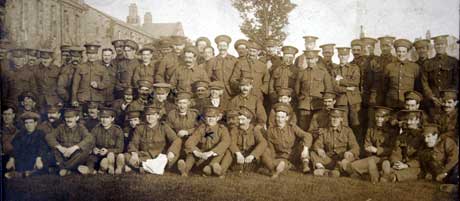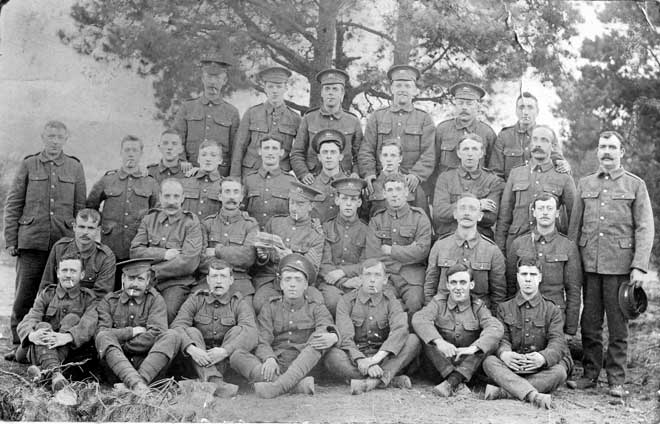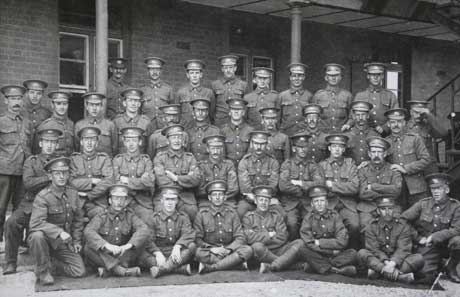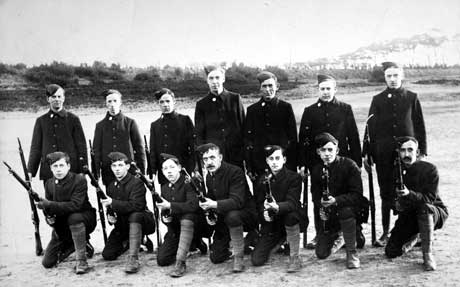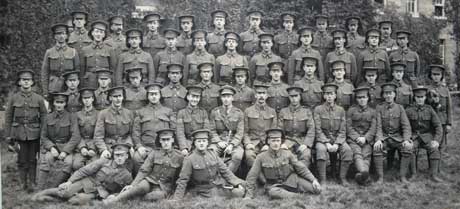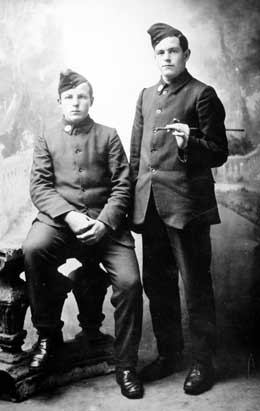 |
King's Own Royal Regiment Museum Lancaster |
|
|
HOME Museum & Collections Sales Donations Events Contact Us REGIMENTAL HISTORY 17th Century 18th Century 19th Century 20th Century First World War Second World War Actions & Movements Battle Honours FAMILY HISTORY Resources Further Reading PHOTO GALLERY ENQUIRIES FURTHER READING LINKS
© Images are copyright, Trustees of the King's Own Royal Regiment Museum. |
WAR! 1914 Lancaster and The King's Own go to War. Generously supported by the Sir John Fisher Foundation. Recruiting Kitchener's Army As soon as war was declared men started to volunteer for service. Newspaper Report Lancaster Guardian 5th September 1914 Recruiting Brisk at Bowerham. Unique scenes have been witnessed at Bowerham Barracks this week in
connection with the enrolment of recruits in the various branches of the
service. Each train brings a number of men who have been sent out from
various Lancashire towns, and owing to the abnormal demands on the
military clothing factories, there was been some delay in their
equipment. The time has not been lost, however, as the men have been
drilled in mufti in the Barracks Fields and Belle Vue Field, and have
been licked into shape by old colour sergeants. The 6th (Kitchener)
Battalion can be raised to 2,000 strong, and efforts are being put forth
to bring up the 3rd (Special Reserve) Battalion to the same strength.
Nearly 300 men from the 3rd Battalion in the South have been drafted to
the Expeditionary force to replace the losses in the 1st Battalion. The
recruits have been attested at the rate of about 200 per day. At the Old
Town Hall business has been brisk. There have been as many as 1,600
recruits at the Barracks at once, and they have been accommodated in the
Bowerham Council School, in bell tents in the football field on the
north of the Barracks, and also in a large marquee in Mr. Mitchell’s
field, Belle Vue. Thanks to townspeople, recruits who turned up in rags
were promptly dealt with, being rigged up in more presentable clothing
sent by sympathetic Lancastrians. The YMCA have erected a tent just
inside the entrance to the field opposite Bowerham School, and the men
have an opportunity to write letters and purchasing temperance
refreshments, etc. Oath to be taken by recruit on Attestation Bowerham Barracks After the mobilisation and equipping of the Regular Reserves and the Special Reserve Battalion was mobilised and sent to Saltash according to schedule, Bowerham Barracks, the King’s Own Depot, was free to deal with the recruitment of the men of the Kitchener’s Army. By the end of September 1914 nearly 7,000 men had passed through the Depot.
Kitchener’s Army Battalions The 1881 localisation of the infantry had brought the King’s Own to
Lancaster and given them North Lancashire as a recruiting area. However,
the population of the area was never enough to provide the number of men
needed. The same applied to the Kitchener Battalions, which were made up
of men who enlisted in towns and cities right across the North West and
arrived in Lancaster to join the King’s Own. 6th Battalion This was the first Kitchener Battalion to be raised for the King’s
Own on 9th August 1914 and by 25th August the first two companies were
sent to Blackdown Camp, Tidworth on Salisbury Plain, to begin their
training, 7th Battalion Raised in Lancaster in September 1914 they were also trained at
Tidworth. They went to the Western Front on 17th July 1915 where they
fought until the battalion was disbanded in early 1918. The soldiers
were transferred to other battalions. 8th Battalion Formed at Lancaster on 11th October 1914 it consisted of 400 men who
had enlisted at the outbreak of the war. The battalion moved to Codford
on Salisbury Plain, later moving to Boscombe near Bournemouth where the
men’s training was continued.
The 6th, 7th and 8th Battalions were made up to full strength with drafts of 350 men each from the Border and Manchester Regiments. 9th Battalion Formed at Lancaster and trained at Seaford, near Eastbourne.
War Horse! The expanding army not only needed men to fill the ranks, they also
required horses. A Remount Depot was established at the Artillery Drill
Shed on Dallas Road, Lancaster. Local suppliers worked with the army to
provide horses which were used both at home and overseas. The depot
could accommodate 150 horses at any one time, which came from as far
away as Canada with 50 reportedly arriving in October 1914. How Old? © Images are copyright, Trustees of the King's Own Royal Regiment Museum. Only a proportion of our collections are on display at anyone time. Certain items are on loan for display in other institutions. An appointment is required to consult any of our collections which are held in store. |

